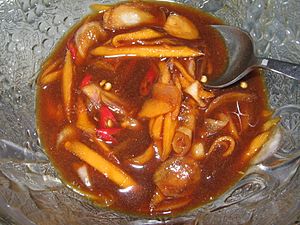Budu (sauce) facts for kids

Budu sauce
|
|
| Type | Condiment |
|---|---|
| Place of origin | Malaysia |
| Region or state | Kelantan and Terengganu regions of Malaysia and Southern Thailand |
| Main ingredients | Anchovy |
Budu (Jawi: بودو; Thai: บูดู, RTGS: budu, pronounced [būːdūː]) is a special sauce. It is made from tiny fish called anchovies. Budu is one of the most famous fermented seafood products. It is very popular in Kelantan and Terengganu in Malaysia. You can also find it in the Natuna Islands of Indonesia. There, it is known as pedek or pedok. It is also found in South Sumatra, Bangka Island, and Western Kalimantan in Indonesia, where it is called rusip. In Southern Thailand, it is also a common food. Budu was first mentioned in a book from 1852.
Contents
How Budu is Made
The Fermentation Process
Making Budu is a traditional process. People mix anchovies and salt together. The amount of anchovies is usually two to six times more than the salt. This mixture then sits for a long time. It ferments for about 140 to 200 days. This long wait helps create its unique flavor. Budu is used to add taste to food. It is often eaten with fish, rice, and fresh vegetables.
Similar Sauces Around the World
Budu is like other fish sauces found in Asia. For example, it is similar to patis in the Philippines. In Indonesia, it is called ketjap-ikan. Myanmar has ngapi, and Vietnam has nuoc mam. Japan has ishiru or shottsuru. In the Indian subcontinent, it is known as Colombo cure. China has yeesu, and Korea has aekjeot. All these sauces use fermented fish.
The Science Behind the Flavor
Budu gets its flavor from a natural process. This process is called hydrolysis. It involves special proteins from the fish. Tiny living things called microbes also help. These microbes create enzymes called proteases. These enzymes break down the fish proteins. This breakdown creates the unique taste and smell of Budu.
Adding Sweetness and Color
Sometimes, palm sugar and tamarind are added to Budu. These ingredients help the sauce turn a dark brown color. This color change is called a browning reaction. The amount of fish compared to salt is very important. Different salt levels change how the microbes and enzymes work. This leads to different flavors in the final product.
Salt-Loving Microbes
The tiny living things found in Budu are special. They are called halophilic microbes. This means they love salt. These microbes are very important. They help break down the proteins in the fish. They also help create the rich flavor and smell of Budu.
Budu's Importance and Health Facts
A Malaysian Heritage Food
Budu is a traditional food for the Malay people. It is especially important in the eastern coastal states of Peninsular Malaysia. These states are Kelantan and Terengganu. The Malaysian Department of National Heritage has even called Budu a Malaysian heritage food. This means it is a special part of their culture. Even Chinese people in Kelantan help make Budu.
Health Information
Anchovies and products like Budu are high in protein. They also contain uric acid. People with a condition called gout should be careful. However, anchovies have less uric acid than tuna. Some studies suggest that Budu might help fight cancer. Since it comes from fish, it may also be good for your brain.
New Ways to Enjoy Budu
In 2011, a student developed a powdered form of Budu. This new form makes it easier to store and transport. It is lighter and less likely to break during travel.
See also
 In Spanish: Budu para niños
In Spanish: Budu para niños

